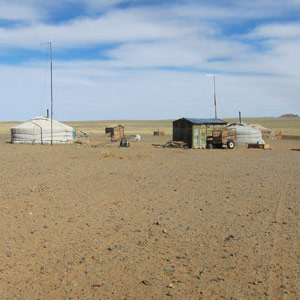Magazine | Voyages
Séjour ornithologique en Mongolie du 21 mai au 1er juin 2013

Campement de yourtes dans la steppe mongole, mai 2013.Photographie : Sébastien Provost
Introduction
La Mongolie est un vaste pays peu peuplé (moins de trois millions d’habitants, dont près du tiers vivent dans la capitale Oulan-Bator) d’Asie centrale situé sur un vaste plateau montagneux incliné d’ouest en est. Le climat est chaud en été et extrêmement froid en hiver, avec des températures pouvant descendre jusqu’à – 40 °C.
Ce pays se situe à la croisée de plusieurs grands écosystèmes : la steppe herbeuse, le désert de sable, la steppe arborée, la prairie alpine et la taïga. Les lacs et les marais sont également nombreux.
Grâce à la diversité de ses habitats et à la très faible densité humaine, la flore et la faune de Mongolie sont variées. L’avifaune est particulièrement intéressante, car on peut à la fois observer des espèces sibériennes et d’Asie centrale. Parmi les « spécialités » citons le Bécassin asiatique, l’Oie cygnoïde, l’Oie à tête barrée, la Perdrix de Daourie, le Vautour de l’Himalaya, le Pygargue de Pallas, le Syrrhapte paradoxal, l’Alouette mongole, le Choucas de Daourie ou la Niverolle du Père David, mais aussi une grande variété de passereaux migrateurs sibériens.
Fort de l’expérience de deux voyages ornithologiques réussis en 2011 et en 2012, Sébastien Provost a organisé un séjour pour un groupe de naturalistes du 21 mai au 1er juin 2013 dans le centre du pays, au sud et au sud-ouest d’Oulan-Bator.
Les participants ont pu observer les oiseaux près de la capitale, dans le nord du désert du Gobi, dans la vallée du temple d’Ongi, dans la vallée de l’Orkhon, le long des berges du lac Ogii, dans les dunes d’Elsen Tasarkhai, dans le parc national Hustai et lors de nombreux arrêts le long des pistes.
Abstract
Mongolia is a large central Asian country with a low density of population (less than three millions people, with nearly a third living in the capital Ulaan Baatar) – situated in a vast mountainous plateau sloping from west to east. The climate is hot in summer and very cold in winter, with temperatures down to -40 ° C.
The country lies at the crossroads of several major ecosystems: grassy steppes, sandy deserts (Gobi), wooded steppes, taiga and alpine meadows. Lakes and marshes are numerous.
Thanks to the diversity of habitats and the very low density of population, the flora and fauna are varied. The avifauna is particularly interesting because both can observe species of Siberian and Central Asia, some of which are endemic. The “specialities” include the Asian Dowitcher, the Swan Goose, the Bar-headed Goose, the Daurian Partridge Jackdaw, the Himalayan Vulture, the Pallas’ Fish-Eagle, the Pallas’ Sandgrouse, the Mongolian Lark, the Azure Tit, the Daurian Jackdaw or the Pere David’s Snowfinsh, but also a wide variety of interesting migratory songbirds.
Having already organized two birding trips in Mongolia in 2011 and 2012, Sébastien Provost leaded a group from the 21th of May to the 1st of June 2013 in the center of the country, in the south – southwest of Ulaan-Baatar. Participants birdwatched in the capital, in the north of the Gobi Desert, in the valley of the Ongi temple, in the Orkhon valley, around the lake Ogii, in the dunes of Elsen Tasarkhai, in the Hustai park and during many stops along the tracks.
Poursuivez la lecture de cet article, en vous abonnant dès maintenant !
Découvrez les Archives d’Ornithomedia.com
Pour seulement 10,00 €TTC/an (ou 6,00 € les 6 mois)
Profitez de plusieurs centaines d’articles en accès illimité et sans aucun engagement.
Compléments
Auteur
Sébastien Provost
Séjour en 2014
Un autre séjour est planifié en Mongolie au printemps 2014 : vous pouvez contacter Sébastien Provost (seb.provost@wanadoo.fr) pour plus d’informations.
À lire aussi sur Ornithomedia.com
La vallée du monastère d’Ongi (Mongolie), un point chaud pour les oiseaux migrateurs sibériens
Ouvrages recommandés
- Birds of Mongolia de Sundev Gombobaatar, Christopher W. Leahy, Shagdarsuren Boldbaatar et Axel Braunlich
- Mongolia Road Map de Gizi Map
- Carte routière : Mongolie de Cartes ITM
- Field guide the birds of the Indian subcontinent de Kazmierczak K. (2000)
- A Field guide to the birds of China de J. & Philipps K. (2000)
- Birds of the Middle East de Porter R.F et al. (1996)
- Birds of East Asia. Eastern China, Taïwan, Korea, Japan and Eastern Russia de Brazil M. (2009)
Sources
- Dubois PJ., Khayankhayrvaa T. Mongolie 20 juin au 4 juillet 2012. Birdquest
- Gombobaatar S, Usukhjargal D. Birds of Hustai National Park.
- Mongolian ornithological society. http://mos.mn/
- Provost S. (2012). Séjour ornithologique en Mongolie. 23 mai au 2 juin 2012.
- Van Beirs M. Mongolia – 26 may – 13 June 2012. Birdquest




Aucun commentaire sur ce sujet
Participer à la discussion !